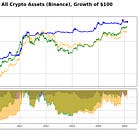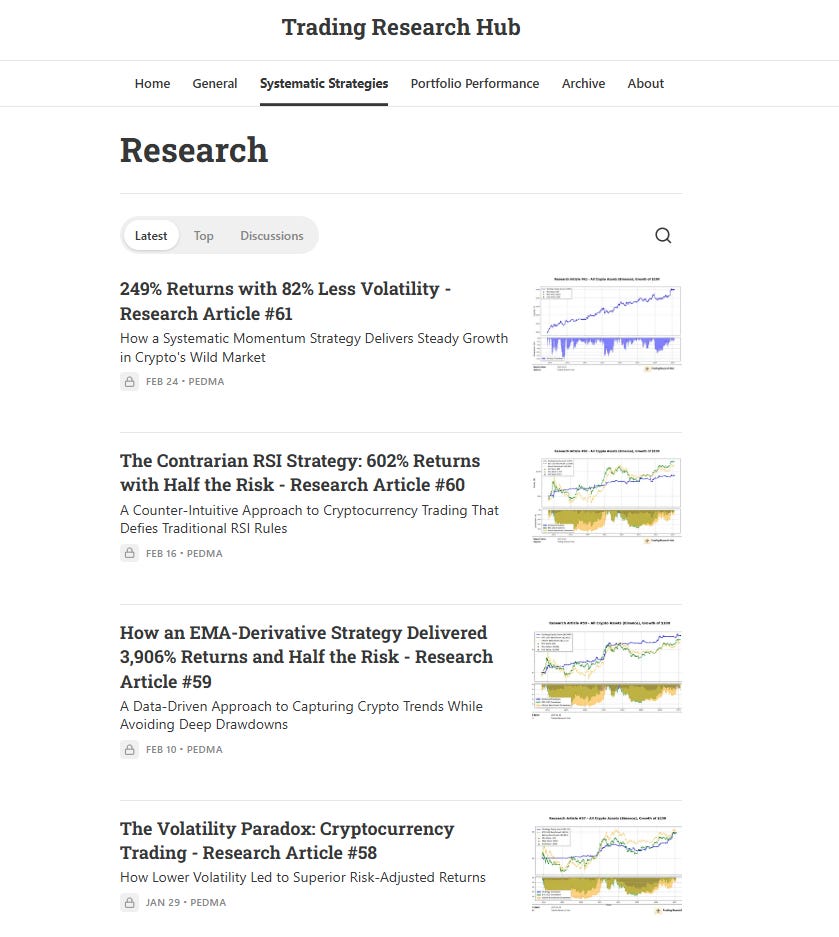How to Build a Profitable Trading Business Faster
How I would become a profitable trader faster if I could go back 7 years.
Hey there, Pedma here! Welcome to this ✨ free edition ✨ of the Trading Research Hub’s Newsletter. Each week, I'll share with you a blend of market research, personal trading experiences, and practical strategies, all aimed at making the world of systematic trading more relatable and accessible.
If you’re not a subscriber, here’s what you missed this past month so far:
If you’re not yet a part of our community, subscribe to stay updated with these more of these posts, and to access all our content.
I started trading in 2017. I had decided that I was going to give this game a fair shot, and to do so, I figured I had to study a lot.
I was clocking in 8h-12h a day studying, after a part-time job that I had at the time. Despite all of this work and sacrifice, I lost money consistently for the following 2-3 years.
Like any 19-20 year old kid, I was attracted to this space from the most famous gurus and influencers, that preferred spending their time showcasing their flashy lifestyle, rather than trading.
They do this to attract an audience of uninformed and desperate people that will continue to fund their lifestyle. It’s a smart business plan, if I am being honest. Dishonest, but smart.
The more people that join their paid courses and memberships, the more money they have to promote it to the next uninformed person.
When these “aspiring traders” arrive at the trenches of the market, they don’t know what to do. Maybe their guru is telling them to trade with their signals, or providing some paint class on how to draw lines on charts.
Obviously as any self-aware person will come to realize, this is no way to trade.
The market is just like any other business. There’s buyers and sellers, and you need the equivalent of a “product or service”, to make your trading business sustainable.
So these traders will continue to be on this never ending spiral of making no progress. They might make a little bit of money every once in a while, only to lose it all on fees and mistakes they do along the way.
It seems that every step they take, they give two or three or even ten back.
It’s frustrating, I know, I’ve been there.
I have shared many times that the reason I turned it around was because I began trading systematic trading strategies.
But that’s NOT the point of today’s article.
Today I want to write what I’d do different if I could talk to my 19/20 year old self, about how to make progress quicker in the markets, and start making money right from the start.
This is an important topic to me because those 2-3 years weren’t easy. To my credit I was putting in the time. It wasn’t that I was slacking and just doing the bare minimum, it was that I had no guidance on sensible things to do in the market.
Had I known what I know today, I’d have been profitable much faster and with far less stress than what I had back then.
The sections below will be numbered, and that indicates the order in which I’d approach trading strategies, if I were new to trading, or an unprofitable trader.
All of this article will be written as if I was talking to myself 7 years ago.
#1 - Stop Chasing Rabbits
The first rule is about focusing on a few things that are known to work, and start making money with those. Trading isn’t about inventing the wheel, and going for the thing that no one knows about. Let’s leave that for the movies.
By going for things that we know already work elsewhere, we are increasing our chances of success by a wide margin.
But with time, you will find out that things that are “known”, have less returns to be extracted from them. And that makes sense right? If something is already working for many decades, have been documented extensively by researchers and academics, why should there be any extra “easy” returns for you?
But the good news is, there’s still returns there for you, not as attractive as one would wish for, but they are there to be collected.
I will leave the question of why they are there for the academics and people with a more scientific mind than mine, but my guess is that these things are not as attractive as other forms of edge are. So they are not exploited to the full capacity that would close them completely.
But for you, that don’t have a profitable strategy yet, you can start doing those things that are hard to do, but that have had the tendency to work for many decades.
And we focus on that, and are proud on that, because as opposed to all the other traders chasing rabbits, we are making money.
#2 - Risk Premium Harvesting
At this point you still don’t have a profitable trading strategy, and you don’t really know if you can make money trading the markets.
So your focus should be on maximizing your odds of making money, given this uncertainty.
But we also don’t want to just stick our capital into government treasury bonds and expect to earn a 2%-4% on our money. That’s not why you’re in this game, I know that.
So let’s do the next more risky thing, and collect some premium for the extra risk we will be taking.
In non-fancy terms, a good ol’ buy and hold!
Markets are risky right? Given that they are risky, investors expect to be paid more in those markets, than they would otherwise in less risky things like government bonds.
For this reason, the extra return that stocks provide (historically) have had a tendency to be above those of the risk free rates.
Since you will be trading for the next 2-3 years without making any money, this means that you’re losing money every year in two ways:
From active trading
From opportunity cost on what you could have collected just by holding risky things.
You will probably be able to collect around 20% if you just stick your money in stocks, and use the remaining money to trade the things that you are interested about.
You don’t need to collect risk premium just on stocks, you can have a mix of things like bonds, gold, even in the cryptocurrencies that you will trade in the future.
Just make sure to rebalance things to a target weight, so you don’t have too much volatility in your portfolio, and just collect that money as you are learning.
Your trading ain’t going nowhere, but the markets are. Not only will you be losing that money on foolish attempts to become a trader, but also add the potential return you could have had, just by doing what we talked about above!
#3 - Market Effects
Ok now that you have established a good baseline, and your capital is at work, if you want to take extra risk and extract a bit more of extra return, you can go to the next thing:
Harvesting returns from known market effects.
What are known market effects? Here’s a list:
Momentum - The tendency of assets that have performed well (poorly) in the recent past to continue performing well (poorly) in the near future
Trend - The tendency of asset prices to move in persistent directions over extended periods
Value - The tendency of relatively cheap assets to outperform relatively expensive ones
Carry - The return earned from holding an asset, excluding price changes (like interest rates, dividends, or roll yield)
Size - The tendency of smaller capitalization securities to outperform larger ones
Quality - The tendency of companies with strong fundamentals (profitability, stability, growth) to outperform
Low Volatility - The tendency of lower-risk assets to deliver higher risk-adjusted returns
Mean Reversion - The tendency of prices to return to their average after extreme movements
Seasonality - Recurring patterns tied to calendar effects (like January effect, month-end flows)
These are known effects that are studied deeply in academic research and practical implementation.
On our “Research Article” series, I release a lot of research mostly focused on these effects. We’ve released 61 articles over the last year, and every week, we release at least one more.
Now let’s look at an example of a fund trading this effect practically, not just academically.
Mulvaney Capital Management has been trading trend-following models since the 90’s! Other funds since the 80’s.
These are robust, long-lasting effects in markets. And it means that they are something you can start doing tomorrow, if you knew how to implement and harvest these returns over the long-term.
There’s a few things you need to know about them though.
They are Weak Edges
In any market, we need to look at things from this logical perspective:
If a source of returns is well known, its returns should be non-existent. If they exist, generally there’s something about it that makes it unattractive for more capitalized players than us, to completely absorb it and leave nothing for the little guy.
That’s a pretty basic assumption.
Imagine that there’s money laying in the middle of a crowded street. Why has no one picked it up? Why is it there waiting for you? The first assumption is that there’s something about it that makes other people stay away from it.
What’s unattractive about a trend edge for example?
Long and lengthy drawdowns
High volatility
Let’s take the example of Mulvaney’s fund performance.
From 2015-2021 , they made almost no money!
That is 6 years of stagnant performance.
There, now you know what’s hard about the strategy, you can go and pursue it, knowing that being patient to harvest it is your edge.
#4 - Alpha Focused Strategies
Now that you are no longer chasing rabbits by extracting risk premium from the market, and collecting returns from those known effects, if you have any time and money left, you can now go for alpha focused strategies.
What is different about this category you ask?
Well it just means that your returns are no longer explained solely by the things we talked about above, but they are unexplained. Or at least you think they are unexplained by the most obvious things.
Since we are trading cryptocurrency markets it will be easier for me to give you a more concrete crypto focused example.
In crypto we have these things called perpetual futures. I am not going to bother you with the details of a perpetual future, but just by the name of it you know it’s a future that has no expiry date.
If it has no expiry date, how does the contract converge with its index price, when there’s an imbalance of demand or supply?
There’s this mechanism called the funding rates.
Every hour, 4-hours or 8-hours, depending on the exchange, a fee is paid/received depending on this gap between the perp and the index, to incentivize traders to keep it trading at balance with the index.
If the perpetual contract is above it’s index price, longs will pay shorts to incentivize selling to bring it back down to what’s supposed to trade at.
If the perpetual contract is below its index price, shorts will pay longs to incentivize buying to bring it back up to what’s supposed to trade at.
However crypto markets are fragmented across a bunch of different exchanges. This generates distortions in fair value of the same asset, that you can try and exploit.
Some may have higher funding, others lower, all due to this fragmented dynamic of this market.
Here’s an example of this:
VANRY funding is -0.1899% at binance
VANRY funding is 0.0100% at bybit
An astute trader, looking for a way to extract returns from the market and being useful, will look at this and consider doing an arbitrage.
Going long on the perpetual contract at binance, going short at bybit, collect the delta of that funding between exchanges, but hedging out the market risk.
Now you have a delta neutral position collecting approximately 200% annualized returns, on a position without directional risk.
Obviously there’s a few “wrinkles” here:
You will pay costs and slippage
Funding changes and is not the same forever
You need a model to trade around profitable after costs
But here’s a trade that it’s very specific, uncorrelated to most things we discussed above, and that you can pursue.
There’s many others like these, that are much riskier for sure, but that can add a nice stream of returns at much higher rates than those of the most “known strategies”.
Next Steps to Building Your Trading Business
Now that you have a solid approach to this trading game, there’s a few more things that you can do, to improve your returns. One of them is to trade the things we discussed above, in less competitive markets like crypto. Places where those weak edges are more pronounced since these markets are more immature.
But that will be for another day.
The point I wanted to bring in today’s article, is that you need to focus on the most obvious things, when you are not making money trading.
I didn’t do that and it cost me many years chasing rabbits.
Had I known what I wrote in today’s short article, it would have saved me literally years and thousands of dollars that at the time were most of my savings.
This is why I write these articles.
Maybe it helps one of you that is on the same journey as I was, lost in a sea of useless content that will do you nothing other than lose you money and your precious time.
I hope you’ve enjoyed today’s article !
Ps… Looking to Work With Me?
After testing 100’s of trading strategies and spending 1,000’s of hours studying trading and building my own models, I had a few clients reach out to work with me and the outcomes have been quite good so far!
I’ve helped multiple clients now:
Develop their first systematic model
Help reviewing their current trading processes
Build solid frameworks on trading system development
Stop wasting money and time on bad ideas
Develop better risk management models
And much more…
If you want my custom help on your trading business, or would like to work with me, book a free 15-minute consultation call:
And finally, I’d love your input on how I can make Trading Research Hub even more useful for you!
Disclaimer: The content and information provided by the Trading Research Hub, including all other materials, are for educational and informational purposes only and should not be considered financial advice or a recommendation to buy or sell any type of security or investment. Always conduct your own research and consult with a licensed financial professional before making any investment decisions. Trading and investing can involve significant risk of loss, and you should understand these risks before making any financial decisions.












been folling you for sometime now as I find your writings insightful. but wanted to ask, have you created an automated system yourself?